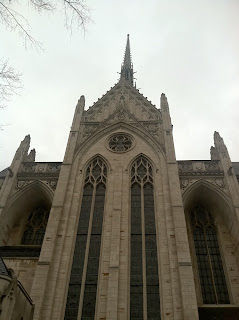Last winter, I published a series of posts that explored some of the best known towns in the valley of the Monongahela River. The coverage was limited to towns along the lower river, in Allegheny County. But there are lots of other interesting old cities upriver and further south. Today, I had an opportunity to walk around downtown Brownsville. It's an intriguing place that looms large in the history of this region, but I've never had the opportunity to give it the attention it deserves. Like all the old Mon Valley towns, I found that I liked the place. Unlike its downriver neighbors--McKeesport, Duquesne, Clairton, and Braddock--Brownsville is not separated from the river by a vast, blighted field where a steel mill once stood, or still stands. It's a pleasant town, perched comfortably right on the banks of the great Monongahela. It's an old town, first settled in the 1750s and 60s. It's a poor town. Nearly all the storefronts along the main street--pictured here--are vacant. There are many derelict houses, and churches, and businesses. I didn't see it, but I'm told there's even a big, abandoned hospital.
Huddling under a bridge--like some fairy tale troll--"Fiddler's" restaurant is a local landmark, and it still does a lively business. Brownsville reminds me very much of my hometown, Oil City, PA. It's got the same small town feel, walkable, livable, built to a human scale. It's got the same interesting old architecture, the same hilly terrain, steep streets, intriguing alleyways, dark windows. There's a forlorn beauty to both towns, though Brownsville is far older...and grittier...and more abandoned.
Locals are making some attempt to spark new development in their community, like this riverside park with its enigmatic solar panels. As much as I like the place, I'm pretty sure I won't be buying a cheap, ramshackle mansion and relocating to Brownsville. I felt conspicuous there. The few people roaming the cold streets were strangely obese, and they looked at me with more suspicion than I liked. Unfortunately, I didn't get a shot of Nemacolin Castle, which has been presiding over the city since the late 1700s. It's not much to look at, but I like anything from the 18th century.


























